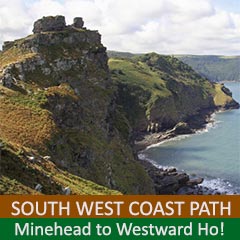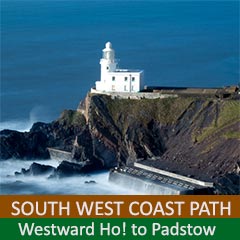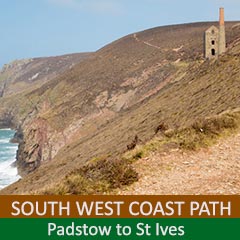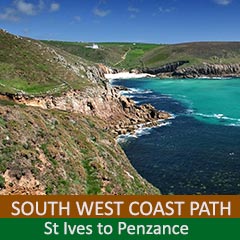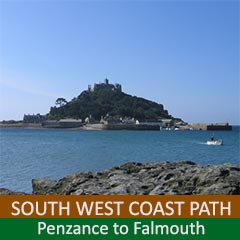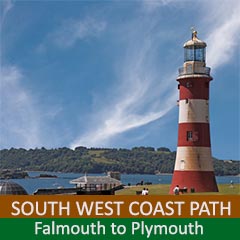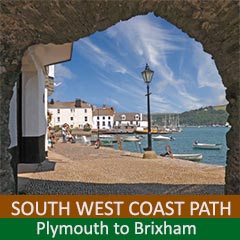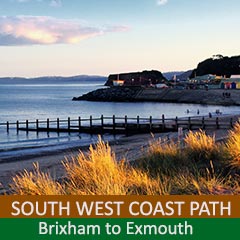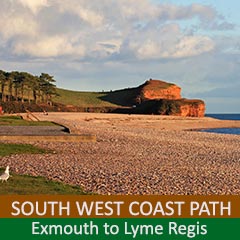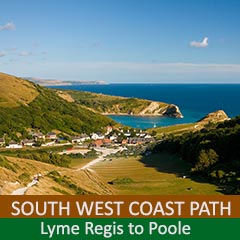Self Guided Walking Holidays
On the South West Coast Path
This 630 mile National Trail extends from Minehead in Somerset through the counties of Devon and Cornwall before ending in the Dorset town of Poole. Each section of this spectacular walk offers its own rewards and highlights. We, at Walk the Trail offer you the chance to walk, explore and relax in some of the most iconic and well known locations the South West of England offers.
Click on an image below for more information
If you are planning to walk every mile and wish to create some amazing memories, we would suggest taking a photograph at the start of this adventure at the monument on Minehead seafront, it is from here that your South West Coast Path experience truly begins. Taking you through small towns and villages in Somerset before you jump over the border into North Devon with Exmoor National Park meeting the Coast Path, this area abounds with uphill and down dale walking through lush wooded valleys, crossing rivers and waterfalls making their way to the Bristol Channel with extensive views of South Wales on the horizon. Contrast this with the more wide-open spaces of the next section from Westward Ho! onwards across the clifftops of North Devon with its hidden and secluded fishing villages lost in the midst of time such as Clovelly before reaching the headland at Hartland Quay and the walk across the border into Cornwall with its mythical and mystical town of Tintagel linking to the Arthurian legends, and Boscastle with the world famous Museum of Witchcraft. Doc Martin fans take note – this is the stretch that takes you to the village of Port Wenn, or Port Isaac when the cameras stop rolling. This section ends in the busy fishing port of Padstow, with its numerous celebrity chefs and the chance to sample some of their, and Cornwall’s finest fare. Saying goodbye to Padstow you travel onwards along the coast path viewing Cornwall’s mining heritage as you pass the ruins of engine houses and stacks, a legacy of the great mining trade now defunct, here the miles of sandy beaches and dunes travel parallel to you, giving you a chance to walk along the seashore and cool those weary feet. Where many trades end, another begins and the town of St Ives provides you with the modern and more artistic view of the county, with its numerous galleries and independent shops and amazing restaurants, this is a perfect location to spend a few days absorbing the light and atmosphere which has drawn painters, potters and poets from all over the world to its little cobbled streets. From here you reach the end of the land, with signposts to prove it – surely another photo opportunity to add to your growing album.
The Lands’ End peninsula boasts numerous ancient sites, as well as grand tourist attractions which should certainly be added to the list of places to visit – The Minack Theatre and Porthcurno Telegraph Museum to name but two. St Michaels Mount in the Mounts Bay hoves into view as you walk around the coast towards Penzance, a busy and diverse town marking the end of the line as far as the Great Western railway is concerned. Don’t forget that the Scilly Isles are just a ferry ride away, so the UK doesn’t end here. The Lizard peninsula also counts itself as the southernmost point of the UK, and the lighthouse at Lizard village attests, as does the fishing village of Porthleven (the most south-westerly harbour on the English mainland), this area is one of diversity, rugged clifftops, little coves and sheltered woodlands need to be traversed before crossing the idyllic Helford river with its many creeks and inlets before arriving in the cosmopolitan town of Falmouth. This town boasts a large and creative university community mixing the bohemian with the traditional maritime history of this sea trading town. This is where the sailors and seafarers amongst you will find the most interesting parts of the coast path, with English maritime history in microcosm between Falmouth and the great city of Plymouth, fishing, trade, and war have shaped this part of the coastline, with numerous picturesque harbours in many of the locations you will visit on your way. This area has given birth to some of England’s most admired writers such as Daphne du Maurier and Kenneth Graham to name but two. After crossing the famous landmark of the Tamar Bridge you arrive in South Devon with its many rivers and inlets giving you a chance to break up your days walking with trips on small ferries, or tide watching to cross estuaries replete with birdwatching opportunities along the way. It is here that you have the chance to explore inland, with the start of the Two Moors Way accessing Dartmoor and Exmoor via Wembury. War enthusiasts can come pay homage to the training grounds of the Second World War at Slapton Sands. The countryside on the South Devon area of the coast path is less rugged, and opens up to reveal open farming land as you walk along the high cliffs towards the seaside destinations of Brixham, with its’ pretty brightly painted houses climbing up from the harbourside. The Victorians created a perfect holiday retreat and getaway when they decided to build around the Torbay area with promenade walking all around the bay with the architecture paying testimony to the wealth that flooded the area. Large imposing buildings now serve as bed and breakfast and hotel accommodation welcoming visitors all through the year to this red sanded tourist haven. Walking here gives you a chance to experience the busy alongside the tranquil, once you have left behind the hustle and bustle of the busy Torquay and Paignton area you climb up onto the high cliffs of Babbacombe and out into wooded nature reserves and green rolling fields as you journey onward to the mouth of the River Exe. From here you literally step back in time with the UNECSO World Heritage Jurassic Coastline stretching out before you, dating back some 250 million years this area of the South Devon and Dorset coastline is a must visit place when exploring the South West. Fossil hunters mix with day-trippers and school groups on the beaches below cracking at rocks and stones in the hope of finding that elusive fossil treasure to take home. Wonderful, welcoming villages are dotted along the coast with fresh local produce in many of the restaurants, giving you a taste of the sea and land that surrounds you. Take time to walk around the town of Lyme Regis , with its literary roots held firm in the memory when standing out on The Cobb, now made famous by the film adaptation of ‘The French Lieutenant’s Woman’, although this is not all Lyme Regis has to offer, with its many bookshops, and the Museum showing the life of Mary Anning, named ‘The greatest fossil hunter’ by the Natural History Museum. As you leave Lyme Regis to travel onward towards the end of the Coast Path you have the mighty Golden Cap to negotiate, this is the highest point on the whole coast of Southern England, and the views from the top of this mighty walk are reward indeed, from here you can see swathes of the coast path both ahead and behind you. This area is gives you a chance to breathe in the fresh air and watch the marine life at play, before arriving at another Victorian seaside town – Weymouth, here you see the epitome of a British seaside town still displaying many of the attractions that have brought people here for so many years, deckchairs sit on the promenade allowing you to watch the rest of the world go by, while you enjoy and ice cream while watching children enjoy the regular Punch and Judy shows on the beach. Upon leaving this town you walk along between one natural and geological wonder to the next with Durdle Door, Lulworth Cove and the limestone folds in the Cove. Lulworth and its surrounding area is still in service as a firing range by the military and can be closed at certain times of the year, so try and arrange your walk to coincide with its opening times or you risk a detour on public transport or by taxi, alternatively you can use this as an excuse to travel inland to visit Corfe Castle. Here on the Isle of Purbeck you have the last chance before ending your walking experience to visit small towns and villages, and the Studland Nature reserve, which teems with both migrating and native birdlife. As you cross over using the ferry at Studland Point over to the end of your journey in Poole, you will have travelled not just the 630 miles of the South West Coast Path, but accrued a multitude of memories which will last longer than the journey you have undertaken. Don’t forget to finish your epic trail with another photograph at the monument marking the end of the trial. Whichever part of the Coast Path you choose to walk, you are guaranteed stunning scenery, excellent food and places to stay with the chance to meet and make many new friends.
